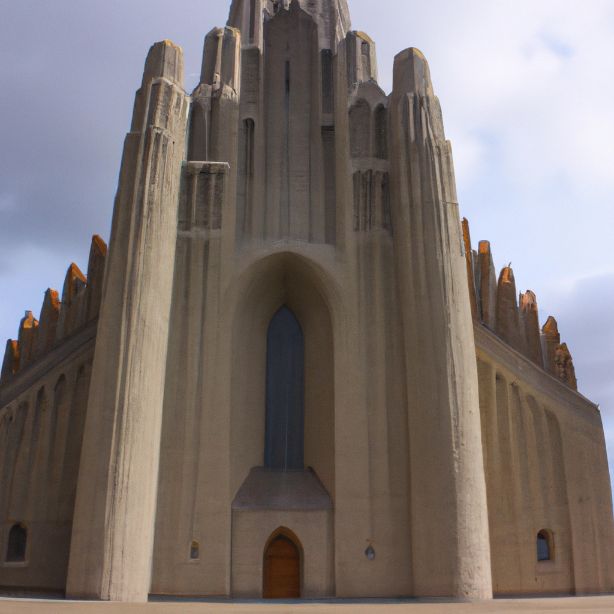Grundtvig’s Church (Copenhagen) : Interesting Facts, Information & Travel Guide

- By
- Aparna Patel
- |
- 15 Jun, 2023
- |

Adventure to Grundtvig’s Church in Copenhagen, Denmark! Located on Bispebjerg Hill in the north of the city, Grundtvig’s Church is a historical landmark and a popular tourist attraction. Built between 1921 and 1940, this striking building has a unique architectural design which features a massive 19th century basilica and a smaller domed chapel. The church is named after the Danish philosopher and pastor Nikolaj Frederik Severin Grundtvig and is an important symbol of the 19th century National Romantic architectural style. As one of the city’s most impressive structures, Grundtvig’s Church offers a lot of interesting facts and unique experiences for visitors. Here, you will learn more about the church’s history, its varied artwork, and its beautiful views of Copenhagen. This article provides an overview of the Grundtvig’s Church and gives travel tips on how to visit and enjoy this fascinating structure.
Table of Contents
Interesting Facts About Grundtvig’s Church (Copenhagen)
1. Grundtvig’s Church is the largest church of the Church of Denmark, and the largest church building in Scandinavia.
2. It was designed in the neo-Gothic style by architect Peder Vilhelm Jensen-Klint and was completed in 1940.
3. Grundtvig’s Church features a 90-meter-long spire, which makes it a landmark across Copenhagen.
4. The church is primarily supported by 24 large, granite pillars, each of which weigh approximately 50 tons.
5. Grundtvig’s Church has become an iconic location for television, film and music video production.
6. It is named after famed Danish hymnist, Bishop and pastor N.F.S. Grundtvig, who was one of the great thinkers of Danish culture in the 1800s.
7. The church organ is the largest in Scandinavia, with over 5,000 pipes and 74 stops.
8. It boasts 15 bells, the heaviest weighing 2.5 tons.
History & Information About Grundtvig’s Church (Copenhagen)
Grundtvig’s Church, located in Bispebjerg, Copenhagen, Denmark is a Lutheran church, and is the most important church within the Danish national church movement. The church was designed by the renowned Danish architect P.V. Jensen Klint and was completed in 1940. The church is named after the Danish hymn writer, theologian and politician N.F.S. Grundtvig.
The Grundtvig church dominates the skyline of the surrounding area, and is considered by many to be one of the finest examples of expressionist church construction. The design of the church is unique in its incorporation of an irregularly shaped tower which stands 128m tall. The interior of the church is equally impressive, with a yellow limewashed nave and colourful murals in the northern and southern aisles.
The church is an integral part of the Danish national movement, and was constructed in order to express the values of the movement and to honour N.F.S. Grundtvig. The church was also the centre for social events, weddings and other gatherings. In the basement of the church there is a museum displaying artefacts related to both the building and the history of the Danish national church movement.
Today, Grundtvig Church is still used regularly for church services and is open for visitors to take in the impressive interior and learn more about the history of the church.
- Aarhus Cathedral (Aarhus) : Interesting Facts, Information & Travel Guide
- Aalborghus Castle (Aalborg) : Interesting Facts, Information & Travel Guide
- Aarhus: Interesting Facts, Culture & Things To Do
Travel Guide For Visiting Grundtvig’s Church (Copenhagen)
1. Getting to Grundtvig’s Church: The easiest way to visit Grundtvig’s Church is to travel with the Copenhagen Metro—line A and F will take you to the Bispebjerg station. Exit the station and walk up Grundtvigsvej to get to the Church. You can also take the bus or boat to the Church from the city centre.
2. When to visit: Grundtvig’s Church is open to the public every day from 10am to 4pm, except on Mondays and Tuesdays, when it is closed. The Church is also closed from mid-December to mid-January.
3. Entrance fees: Entrance to the Church is free. However, visitors can also purchase tickets to take a tour of the Church for a small fee.
4. Things to see: Grundtvig’s Church is an impressive example of Danish expressionist architecture. The interior of the Church is also quite unique, and is made up of a series of small chapels connected by winding staircases. It is also home to a large pipe organ, which is now maintained and operated by the Danish Royal Philharmonic.
5. Other nearby attractions: While visiting Grundtvig’s Church, visitors can also explore some of the other architecturally remarkable buildings in Copenhagen, including Christiansborg Palace and City Hall. In addition, Copenhagen is full of great historical attractions and museums, such as the National Gallery and Rosenborg Castle.
- Roskilde: Interesting Facts, Culture & Things To Do
- Skagen, DK: Interesting Facts, Culture & Things To Do
Frequently Asked Questions About Grundtvig’s Church (Copenhagen)
Q: Who designed Grundtvig’s Church?
A: Grundtvig’s Church was designed by the renowned Danish architect, P.V. Jensen-Klint in the 1920s.
Q: Is Grundtvig’s Church still in use?
A: Yes, Grundtvig’s Church is still active and many services and events are held here.
Q: What is the architecture style of this church?
A: Grundtvig’s Church is a mixture of expressionist, Gothic and traditional Danish rural church styles. The iconic spire is an example of expressionist architecture.
Q: What can I see inside Grundtvig’s Church?
A: Inside, visitors can see the amazing plaster ceiling, a glockenspiel, and the colorful paintings on the ceiling and walls.
Search Posts
Latest posts
-
4 Mar, 2024
Can I accidentally miss the in-flight food?
-
4 Mar, 2024
Why are there no seat belts on trains?
Popular posts
-
5 Mar, 2024
Why prohibit engine braking?